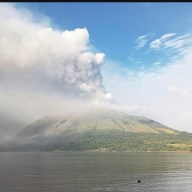PORT HAWKESBURY, N.S. – Riding through a West Coast state three decades ago on a motorcycle, two hungry riders — my wife and I — stopped at a small roadside restaurant and asked for a couple of seats so we could enjoy steaks that were advertised on the chalkboard.
But instead of being shown a menu, we were shown the door. It wasn’t quite as bad as the classic 1969 movie “Easy Rider,” where the bikers were physically attacked by locals, but the manager did snap that her establishment didn’t serve our kind.
As the years have passed and the number of two-wheeled travellers has blossomed into a new market, there’s a new attitude out there toward two-wheeled tourers.
Across the continent on a ride from southern Maine to Nova Scotia’s Cape Breton Island, official tourism offices and vendors themselves couldn’t have been more accommodating.
At provincial welcome centres in Nova Scotia and New Brunswick, counter assistants did more than trace the way to destinations on a map. Using their computers, they provided a list of local bed-and-breakfasts or other lodging places, tracked the prices and number of vacancies. They were glad to make phone calls to the innkeepers on our behalf, and then let us book our rooms on the spot.
All while we were wearing our leather riding gear.
Innkeepers are glad to see the motorcycle business, said Monika Frick, owner of a bed-and-breakfast in the charming St. Andrews, where seven-metre Bay of Fundy tides ebb and flow against New Brunswick’s shore. Thousands of bikers converged on the town for this summer’s Atlanticade motorcycle festival, filling virtually every room around and sending many to outlying towns.
“I liked it a lot,” said Frick, a former rider herself. “My B&B is always open to bikers and I always take my car out of the carport for bikers.”
There’s really no comparison between riding in a car and on two wheels, especially on roads the Maritimes offer. On a motorcycle, you’re not in a metal box just passing through, but rather part of the outdoor scene, where the sights have a more panoramic impact and sounds clearer and smells cleaner. As for the feeling of wind flying through your hair, forget it. Canadian provinces require helmet use.
In Nova Scotia, Cape Breton’s celebrated Cabot Trail, 300 kilometres of spectacular ocean and highland vistas, has long been a major draw for serious motorcyclists. The winding road cuts through forested mountainsides, hugs seaside cliffs and overlooks deep river gorges, offering riders one breathtaking view after another. There are plenty of scenic pull-over spots along the way.
Within reach of the highlands national park, the names provide a Scottish allure of their own: Inverness, Dunvegan, Ingonish to name a few.
All over the island, they’ve seen a bike or two. As if to prove the point, provincial tourism officials provide a motorcycle tour guide booklet filled with information about events, vendors and suggested tours. And not all of them lead to scenic fishing villages, art fairs, beaches and museums.
One offbeat offering suggests a visit to the Charles MacDonald Concrete House Museum in Centreville, known as “the concrete house with the deer statues.”
We bypassed that one, but on our return trip via Prince Edward Island, we couldn’t resist a side run to the Bottle Houses in Cap-Egmont on the southern shore: A cottage, tavern and chapel all constructed from more then 25,000 bottles of all sizes, colours and shapes. On a more serious and cultural note, we took in a performance of bagpipes, snare drums and traditional Scottish dances College of Piping and Celtic Performing Arts of Canada in P.E.I.’s delightful harbour-side town of Summerside.
The Maritime provinces are full of loops and byways off the main routes that may take a little longer, but offer a closer-up view of the passing farms, harbours and small villages that compose the fabric of the place. Our choice from Amherst, near the border with New Brunswick, was Route 6, a good road with minimal traffic and plenty of long curves along the shore of Northumberland Strait.
Returning from Cape Breton, we entered Prince Edward Island via ferry from Nova Scotia’s Pictou Harbor, offering us an easy shot to Charlottetown in a light rain. But the next day the sun returned in full strength as we headed past rolling potato fields and to Summerside, which serves as a start of P.E.I.’s loop of its own North Cape that pokes into the Gulf of St. Lawrence.
We left the island by the famed, 13-kilometre Confederation Bridge, a breathtaking venture in its own right. The bridge connects P.E.I. and New Brunswick. A tip to travellers: There’s no fare entering the island, you pay when you leave. So we skipped the $40-per-motorcycle charge on the ferry and paid C$17.50 to leave. (As of early August, Canadian and U.S. dollars were nearly equal in value.)
It’s not as if the Canadians have a monopoly on hospitality. States welcome motorcyclists too, many with websites that provide links appealing to two-wheeling travellers. It fits in with their desire to find niche markets and so-called drive markets, comprising travellers who can get there in a day on their own wheels, says the U.S. Travel Association.
The national non-profit travel trade association was not sure how many states offer assistance to travellers making reservations at their welcome sites, but said most states have booking portals on their websites. Pennsylvania welcome centres book visitors for overnight lodging, and promote motorcycle tours in through regional tourism agencies, said state tourism spokesman Michael Chapaloney.
Other states also do what they can to make bikers feel at home, such as Arkansas at http://www.arkansas.com/outdoors/motorcycling. And if you want to check out Nova Scotia’s guide, it’s available at http://www.motorcycletourguidens.com.
















